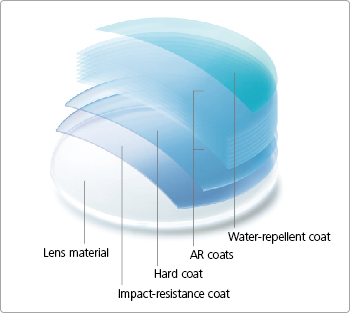1. Applying advanced functions to thin films

Coating technology in everyday life
Coating means covering the surface of an object with thin films. These films essentially add a new property to the object substrate.
Coating is employed for almost everything, from everyday items like cars, home appliances and chocolates to industrial machinery. The latest coating technologies have a variety of applications, from decoration, water- and scratch-resistance, to blocking electrical conductivity. Floors alone, for example, have layers of coating for waterproofing, anti-bacterial protection, impact-resistance and improved fire-resistance.
Today's ophthalmic lenses have several coats, each of which is a few nanometers to micrometers thin. They provide lenses with ultraviolet-light blocking and anti-fog as well as simple scratch- and dust-protection capabilities. To ensure enhanced vision, the design of coatings is as crucial as the design of the lens itself.
Adding as many capabilities as possible to such a thin lens is a vital factor in improving the performance and increasing the value of ophthalmic lenses today. As lens manufacturers have explored this challenge and made great efforts to meet expectations over the years, lens coating technology has undergone great advancements.
2. Anti-reflective coatings: enhancing control of light transmittance

Multilayer coating on an ophthalmic lens
Mechanism of an AR coat
Ophthalmic lens coatings generally fall into four categories. The lowest layer closest to the lens surface is an impact-resistance coat. Above this is a hard coat, which protects the lens from scratches.
The outermost layer is a water-repellent coat that prevents smudges from forming and allows easy wiping off of oil films caused by fingerprints. It also minimizes scratches created by repeated wiping, dust and nearly invisible sand grains.
Between the hard coat and water-repellent layer are anti-reflective (AR) coats, crucial for the lens to achieve clear vision.
The AR coats control the light reflection on the surface by taking advantage of an optical physics phenomenon called interference, which occurs when two rays meet. Light is essentially an electromagnetic wave. When two waves of the same waveform are superimposed in phase — their crests and troughs coincide with each other — they form a larger, amplified wave, as seen in waves in the ocean. This is called constructive interference. On the other hand, destructive interference occurs when these waves are out of phase, forming a smaller wave or canceling each other out.
Without AR coats, the lens would reflect some of the light, decreasing transmittance. On a lens with a layer of AR coat applied, some rays are reflected on the surface of the coating while others are still reflected on the lens surface. By controlling these two groups of light waves to cancel each other out, the lens reduces reflection, allowing more light to pass through. As a single coat is effective for light waves of a limited wavelength band, a lens usually has multiple layers of AR coat to control a variety of rays. With this multilayering, a lens cuts down a variety of light reflection and increases transmittance, providing brighter vision to the user.
Applying this mechanism, an advanced lens coating technology has been developed to maintain the ocular health of everyone, including those who are not in need of conventional ophthalmic lenses. It is now attracting people's attention.
3. An innovative lens coating for the demands of a new age

SeeCoat Blue Premium blocks approx. 35 percent of light in the blue-light wavelength range of 380 to 500 nm.
As the widespread use of smartphones, tablet devices and computers increases the time we face a screen, more and more people suffer from eyestrain symptoms. One cause of this is believed to be the blue light emitted from the display on such devices.
The shorter the wavelength, the stronger energy a light wave has, and this may cause eye fatigue. Blue light, which is next to ultraviolet light on the electromagnetic spectrum, has a shorter wavelength than other visible light. It also tends to be diffused and is believed to cause flickering in the vision.
SeeCoat Blue was developed in 2011, as the first lens coating technology in the world that effectively reduces incoming blue light to the eyes. Blue-light reduction can be attempted by tinting lenses in yellow, which absorbs blue light. But some consumers may shun wearing yellow lenses. Instead, SeeCoat Blue adopted AR coating technology. Taking advantage of the principles of AR coating in the opposite way, SeeCoat Blue prevents blue light from passing through the lens by increasing the reflection of blue light.
It is an advanced lens coating technology that controls the look and properties of ophthalmic lenses while maintaining their basic functions.
SeeCoat Blue Premium, a new development in December 2012, improved blue-light reduction to approx. 35 percent by employing a new and more effective lens material that absorbs blue light, as well as advancing the coating technology. In addition, SeeCoat Blue Premium is designed to meet more current demands; it reduces not only blue light that causes flickering in the vision, but also ghost effects and the ultraviolet light reflected on the back of the lens.
Since the development of a lens coating for cutting blue light, the applications of ophthalmic lenses have expanded; they can now be employed for the maintenance of the optical health of everyone as well as for conventional vision correction. Meeting such needs of the digital age, this is an epoch-making lens coating technology.

